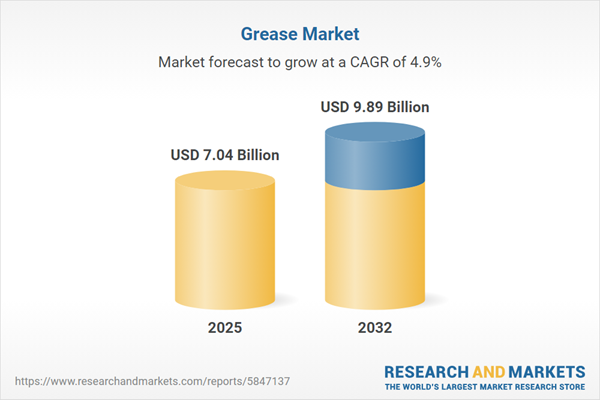Speak directly to the analyst to clarify any post sales queries you may have.
The grease market is evolving rapidly, shaped by technological innovations, shifting regulatory demands, and growing sustainability imperatives. Senior decision-makers face a dynamic landscape where lubricant performance, digitalization, and supply chain resilience drive operational priorities across industries.
Market Snapshot: Grease Market Overview
The grease market is experiencing steady growth, advancing from USD 6.73 billion in 2024 to USD 7.04 billion in 2025, reflecting strong industrial demand, technology-driven product evolution, and regulatory influences. With an anticipated CAGR of 4.92%, the market is projected to reach USD 9.89 billion by 2032, underscoring robust opportunities for established players and new entrants seeking to address performance, compliance, and sustainability.
Scope & Segmentation of the Grease Market
This report provides a comprehensive analysis across multiple market facets and technology trends, ensuring relevance for decision-makers seeking targeted strategies.
- Product Types: Aluminium complex, barium complex, bentone, calcium, lithium, polyurea, and sodium greases.
- Base Oils: Bio-based, mineral, and synthetic oils tailored to a spectrum of performance and regulatory needs.
- Thickener Types: Inorganic, metallic soap, and non-soap thickeners used for specialty applications and enhanced performance.
- Packaging Formats: Cans, cartridges, drums, and pails serving both bulk industrial and precision requirements.
- Distribution Channels: Offline industrial networks and growing online sales channels addressing just-in-time and specialized procurement demands.
- Applications: Automotive (commercial vehicles, passenger vehicles), construction and mining, electrical and electronics, food processing, industrial (heavy machinery, manufacturing equipment), marine and shipboard, and oil and gas.
- Regions: Americas (North America: United States, Canada, Mexico; Latin America: Brazil, Argentina, Chile, Colombia, Peru), Europe, Middle East & Africa (Europe: United Kingdom, Germany, France, Russia, Italy, Spain, Netherlands, Sweden, Poland, Switzerland; Middle East: UAE, Saudi Arabia, Qatar, Turkey, Israel; Africa: South Africa, Nigeria, Egypt, Kenya), and Asia-Pacific (China, India, Japan, Australia, South Korea, Indonesia, Thailand, Malaysia, Singapore, Taiwan).
- Technology Trends: Industry 4.0-enabled lubrication, digital monitoring systems, advanced thickener chemistry, bio-based innovations, and circular packaging strategies.
Key Takeaways for Senior Decision-Makers
- Manufacturers are shifting toward digital lubrication management and sensor-driven monitoring to reduce downtime and enable predictive maintenance strategies.
- Bio-based and synthetic grease formulations are gaining market share due to regulatory changes and customer sustainability mandates, particularly in automotive, food processing, and marine sectors.
- Enhanced packaging, such as refillable and recyclable systems, is supporting corporate environmental objectives and waste reduction goals.
- Online sales platforms are increasing their influence, supporting faster, more tailored supply to industrial and niche clients requiring specialized lubrication products.
- Regional differences in regulations and end-user requirements drive the need for localized production, agile supply chains, and customization at scale.
Tariff Impact on Market Structures (2025 Focus)
Recently introduced tariffs in the United States are increasing raw material costs for greases, particularly advanced thickeners and high-performance base oils. This has prompted a shift toward nearshoring, diversification of supplier networks, and adaptive procurement contracts within the sector. Inventory management and real-time supply chain visibility have become strategic imperatives for maintaining market responsiveness and mitigating the effects of trade policy shifts.
Methodology & Data Sources
This report utilizes a multi-method approach. Primary research involved in-depth interviews with key industry stakeholders and technical experts. This was complemented by validation against secondary sources—regulatory filings, trade publications, and industry databases—ensuring accuracy and breadth in coverage. All trends and insights were rigorously cross-verified and triangulated to maintain credibility for strategic planning.
Why This Report Matters to Industry Leaders
- It equips senior executives with actionable intelligence on innovation, regulatory shifts, and evolving end-user expectations across global markets.
- The analysis identifies strategic opportunities for growth, co-development partnerships, and differentiated service models, supporting long-term organizational resilience.
- The coverage offers detailed competitive profiling and segmentation insights, allowing firms to benchmark their positioning and refine market entry or expansion strategies effectively.
Conclusion
The grease market’s changing landscape presents both challenges and opportunities. Focused investment in sustainable innovation, digital management tools, and adaptive supply strategies will support operational excellence and competitive differentiation in evolving global conditions.
Additional Product Information:
- Purchase of this report includes 1 year online access with quarterly updates.
- This report can be updated on request. Please contact our Customer Experience team using the Ask a Question widget on our website.
Table of Contents
3. Executive Summary
4. Market Overview
7. Cumulative Impact of Artificial Intelligence 2025
Companies Mentioned
The companies profiled in this Grease market report include:- 3M Company
- AB SKF
- Axel Christiernsson International AB
- BECHEM Lubrication Technology LLC
- BP PLC
- Calumet Specialty Products Partners, L.P.
- Chevron Corporation
- China Petrochemical & Chemical Corporation
- CHS Inc.
- CITGO Petroleum Corporation
- DuPont de Nemours, Inc.
- ENEOS Corporation
- Enilive S.p.A
- Exxon Mobil Corporation
- Fuchs Petrolub SE
- Gazpromneft - Lubricants Ltd.
- Gulf Oil International Ltd.
- Harrison Manufacturing Co. Pty Ltd.
- Hexol Lubricants
- Honeywell International Inc.
- Idemitsu Kosan Co., Ltd.
- Indian Oil Corporation Limited
- Kluber Lubrication Munchen SE & Co. KG
- Lanxess AG
- Lubri-Lab Inc.
- Marathon Petroleum Corporation
- Metalube Group
- Mitsubishi Corporation
- Neste Corporation
- Nippon Grease Co., Ltd.
- Orlen Group
- Penrite Oil Company
- Petroliam Nasional Berhad
- Petromin Corporation
- Phillips 66 Company
- Sasol Limited
- Shell PLC
- The Lubrizol Corporation
- The PJSC Lukoil Oil Company
- TotalEnergies SE
- Valvoline Inc.
Table Information
| Report Attribute | Details |
|---|---|
| No. of Pages | 197 |
| Published | November 2025 |
| Forecast Period | 2025 - 2032 |
| Estimated Market Value ( USD | $ 7.04 Billion |
| Forecasted Market Value ( USD | $ 9.89 Billion |
| Compound Annual Growth Rate | 4.9% |
| Regions Covered | Global |
| No. of Companies Mentioned | 42 |









